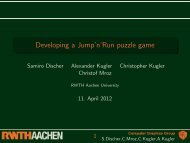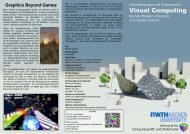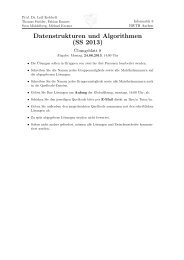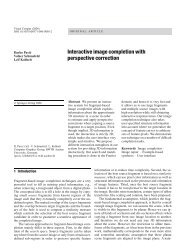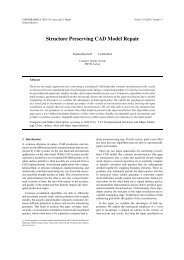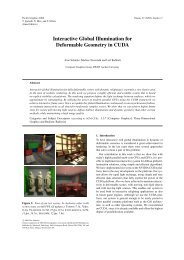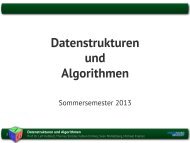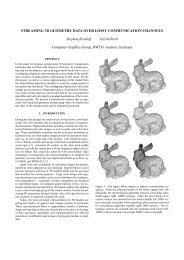sqrt(3) subdivision - Computer Graphics Group at RWTH Aachen
sqrt(3) subdivision - Computer Graphics Group at RWTH Aachen
sqrt(3) subdivision - Computer Graphics Group at RWTH Aachen
Create successful ePaper yourself
Turn your PDF publications into a flip-book with our unique Google optimized e-Paper software.
n£2 ¥¤ 2¢ 2<br />
2π 1 n¥ cos£<br />
¦ 9<br />
the analysis. Its eigenvalues are:<br />
1<br />
9<br />
3α<br />
9¤ £ 2¦<br />
n ¥<br />
2 ¤ 2¢ 2<br />
2π 1 n<br />
¥ ¤©§¨§¨§¨¤ cos£ 2 2¢<br />
cos£ 2π n¦<br />
1¥¢¡ (4)<br />
n<br />
From [Rei95, Zor97] it is known th<strong>at</strong> for the leading eigenvalues,<br />
sorted by decreasing modulus, the following necessary conditions<br />
have to hold<br />
λ 1<br />
1 £ λ 2<br />
λ 3 £ λ i ¤ i 4¤¨§¨§©§¨¤ n¢ 1§ (5)<br />
Additionally, according to [Pra98, Zor97], a n<strong>at</strong>ural choice for the<br />
eigenvalue λ 4 is λ 4 λ 2 2 since the eigenstructure of the <strong>subdivision</strong><br />
m<strong>at</strong>rix can be interpreted as a generalized Taylor-expansion of the<br />
limit surface <strong>at</strong> the point p. The eigenvalue λ 4 then corresponds<br />
to a quadr<strong>at</strong>ic term in th<strong>at</strong> expansion. Consequently, we define the<br />
value for α n by solving<br />
Figure 5: The gap between triangles from different refinement levels<br />
can be fixed by temporarily replacing the larger face by a triangle<br />
fan.<br />
¡2<br />
α<br />
3¦<br />
2<br />
which leads to<br />
α n<br />
4¦ 2<br />
cos£<br />
2π<br />
n<br />
¥<br />
9<br />
where we picked th<strong>at</strong> solution of the quadr<strong>at</strong>ic equ<strong>at</strong>ion for which<br />
the coefficient α n always stays in interval0¤ the 1and (2) is a convex<br />
combin<strong>at</strong>ion. The explan<strong>at</strong>ion for the existence of a second<br />
solution is th<strong>at</strong> we actually analyse a double stepS RS 2 . The real<br />
£ eigenvalue 2 α 3¦<br />
2 n ofS corresponds to the eigenvalue 2 α ¥ 3¦<br />
(6)<br />
n of<br />
S both with the same eigenvector¦ 3α n ¤ 1¤¨§¨§¨§¨¤ 1which is invariant<br />
under R. Obviously we have to choose α n such th<strong>at</strong> neg<strong>at</strong>ive real<br />
eigenvalues of S are avoided [Rei95].<br />
Equ<strong>at</strong>ions (1), (2) and (6) together completely define the smoothing<br />
oper<strong>at</strong>or for our st<strong>at</strong>ionary <strong>subdivision</strong> scheme since they provide<br />
all the necessary inform<strong>at</strong>ion to implement the scheme. Notice<br />
th<strong>at</strong> the spectral properties of the m<strong>at</strong>rices S andS are not sufficient<br />
for the actual convergence analysis of the <strong>subdivision</strong> scheme. It is<br />
only used here to derive the smoothing rule from the necessary conditions!<br />
The sufficient part of the convergence analysis is presented<br />
in the Appendix.<br />
4 Adaptive refinement str<strong>at</strong>egies<br />
Although the complexity of the refined meshes M k grows slower<br />
under ¢ 3-<strong>subdivision</strong> than under dyadic <strong>subdivision</strong> (cf. Fig. 13),<br />
the number of triangles still increases exponentially. Hence, only<br />
rel<strong>at</strong>ively few refinement steps can be performed if the resulting<br />
meshes are to be processed on a standard PC. The common techniques<br />
to curb the mesh complexity under refinement are based<br />
on adaptive refinement str<strong>at</strong>egies which insert new vertices only<br />
in those regions of the surface where more geometric detail is expected.<br />
Fl<strong>at</strong> regions of the surface are sufficiently well approxim<strong>at</strong>ed<br />
by large triangles.<br />
The major difficulties th<strong>at</strong> emerge from adaptive refinement are<br />
caused by the fact th<strong>at</strong> triangles from different refinement levels<br />
have to be joined in a consistent manner (conforming meshes)<br />
which often requires additional redundancy in the underlying mesh<br />
d<strong>at</strong>a structure. To reduce the number of topological special cases<br />
and to guarantee a minimum quality of the resulting triangular<br />
faces, the adaptive refinement is usually restricted to balanced<br />
meshes where the refinement level of adjacent triangles must not<br />
differ by more than one gener<strong>at</strong>ion. However, to maintain the mesh<br />
balance <strong>at</strong> any time, a local refinement step can trigger several additional<br />
split oper<strong>at</strong>ions in its vicinity. This is the reason why adaptive<br />
refinement techniques are r<strong>at</strong>ed by their localiz<strong>at</strong>ion property, i.e.,<br />
Figure 6: The gap fixing by triangle fans tends to produce degener<strong>at</strong>e<br />
triangles if the refinement is not balanced (left). Balancing<br />
the refinement, however, causes a larger region of the mesh to be<br />
affected by local refinement (right).<br />
by the extend to which the side-effects of a local refinement step<br />
spread over the mesh.<br />
For refinement schemes based on the dyadic split oper<strong>at</strong>ion, the<br />
local splitting of one triangular face causes gaps if neighboring<br />
faces are not refined (cf. Fig. 5). These gaps have to be removed<br />
by replacing the adjacent (unrefined) faces with a triangle fan. As<br />
shown in Fig. 6 this simple str<strong>at</strong>egy tends to gener<strong>at</strong>e very badly<br />
shaped triangles if no balance of the refinement is enforced.<br />
If further split oper<strong>at</strong>ions are applied to an already adaptively refined<br />
mesh, the triangle fans have to be removed first since the corresponding<br />
triangles are not part of the actual refinement hierarchy.<br />
The combin<strong>at</strong>ion of dyadic refinement, mesh balancing and gap fixing<br />
by temporary triangle fans is well-known under the name redgreen<br />
triangul<strong>at</strong>ion in the finite element community [VT92, Ver96].<br />
There are several reason why ¢ 3-<strong>subdivision</strong> seems better suited<br />
for adaptive refinement. First, the slower refinement reduces the expected<br />
average over-tessel<strong>at</strong>ion which occurs when a coarse triangle<br />
slightly fails the stopping criterion for the adaptive refinement but<br />
the result of the refinement falls significantly below the threshold.<br />
The second reason is th<strong>at</strong> the localiz<strong>at</strong>ion is better than for dyadic<br />
refinement and no temporary triangle fans are necessary to keep the<br />
mesh consistent. In fact, the consistency preserving adaptive refinement<br />
can be implemented by a simple recursive procedure. No<br />
refinement history has to be stored in the underlying d<strong>at</strong>a structure<br />
since no temporary triangles are gener<strong>at</strong>ed which do not belong to<br />
the actual refinement hierarchy.<br />
To implement the adaptive refinement, we have to assign a gener<strong>at</strong>ion<br />
index to each triangle in the mesh. Initially all triangles of<br />
the given mesh M 0 are gener<strong>at</strong>ion 0. If a triangle with even gener<strong>at</strong>ion<br />
index is split into three by inserting a new vertex <strong>at</strong> its center,<br />
the gener<strong>at</strong>ion index increases by 1 (giving an odd index to the new<br />
triangles). Splitting a triangle with odd gener<strong>at</strong>ion index requires to<br />
find its ”m<strong>at</strong>e”, perform an edge flip, and assign even indices to the<br />
resulting triangles.<br />
For an already adaptively refined mesh, further splits are performed<br />
by the following recursive procedure



